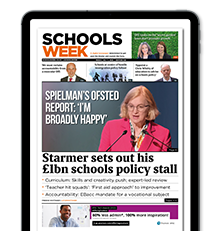Maths teachers in Voice 21 oracy schools are less likely to access professional development in oracy than teachers and leads of other subject areas. Research tells us that high quality dialogue has the capacity to improve outcomes in maths, and yet we know that students don’t instinctively understand how to engage effectively in classroom talk.
With this in mind, we have spent the past year working with schools and external organisations to better understand the role of oracy in maths. We have surfaced several practices that we believe lead to better dialogue by encouraging participation, deepening mathematical thinking and strengthening subject knowledge.
Connecting language to subject identity
Articulating what it means to ‘be a mathematician’ connects the oracy skills students develop in class to disciplinary practice, creating a shared understanding of the purpose of dialogue in mathematics. Linking language to the creativity of mathematical thinking and practices encourages students to perceive talk as a tool for ‘doing’ maths.
What can teachers do?
Signal to students that they are expected to think and speak in subject-specific ways. Subtle shifts in teacher language use – such as “talk to the mathematician next to you” – can support this.
Deconstruct what it means to be a mathematician by linking maths to skills such as reasoning, collaboration, problem-solving and creative thinking. You could create a visual (e.g. a poster) to support this which you return to during maths lessons – linking students’ work in the classroom to real-world mathematical practice.
Planning opportunities for exploratory talk
To build a classroom culture where dialogue is both a tool for learning and aproduct of learning, it is essential to provide opportunities for students to engage in exploratory talk. This type of talk builds curiosity and encourages students to consider and respond to multiple perspectives. Exploratory talk offers genuine insights into students’ mathematical understanding and ways of thinking. Being explicit about how to engage in exploratory talk is essential to support effective dialogue.
What can teachers do?
Teach students about the different roles involved in exploratory talk. Voice 21’s ‘Talk Tactics’ are a good place to start and include sentence starters to support students as they become more proficient in this type of interaction.
Expect students to provide extended responses (though not necessarily complete or ‘correct’ ones). Making processing and reasoning visible to the group will lead to increasingly dialogic exchanges in which students probe different aspects of each other’s ideas, building new understanding along the way.
Promote listening. Encourage students to ask questions about specific details in each other’s responses, for example ‘What did you do to get 120?’ or ‘How do you know the angle is 60°?’
Harnessing errors as a springboard
Building a culture where making mistakes and exploring misconceptions through talk is central to learning encourages students to see error as a necessary part of understanding and applying new mathematical concepts and methods.
Through whole-class discussion, refining an answer becomes a collective undertaking as the thinking that led to an error or misconception is explained, listened to and understood before being adjusted. In a classroom where mistakes are communicated rather than hidden, answering a question becomes the instigation of ‘inter-thinking’ rather than the presentation of a final idea.
What can teachers do?
Step back and create space for student talk. Students might not find the right answers or most effective methods immediately but by allowing time for students to share emerging ideas, you can identify and address the root of errors without interrupting students’ thinking.
Praise participation as well as right answers. This approach builds students’ confidence to offer their thinking to the group and to respond to others’ ideas without fear of ‘getting it wrong’ – which can be just as helpful as getting it right!
High-quality dialogue in maths has the capacity to support students to co-construct knowledge leading to deeper understanding of mathematical concepts and processes. Creating the conditions for effective classroom talk takes time but is time well spent.







Your thoughts